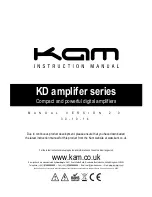
11
2.12 Connecting subwoofers
2.12.1 Active subwoofers without filters
If you use an active subwoofer (with built in power amplifier), simply connect it's input to the proc out (21)
and adjust the bass level at the subwoofer. If the subwoofer has a trigger input, connect it to the trigger
output (26).
2.12.2 Active subwoofers with built in filters
Most active subwoofers have a built in frequency divider network. They receive the full range signal from the
amplifier and feed the filtered signal (full range minus bass) back. This kind of subwoofer can be connected
to the processor in / output: Connect the subwoofer's inputs to the processor outputs (21) and the
subwoofer's outputs to the processor inputs (22). Now activate the processor function (see chapter 4.14).
If the subwoofer has a trigger input, connect it to the trigger output (26).
2.13 Connecting the loudspeakers (A3.2 and A5.2)
2.13.1 A3.2
Connect the speakers to the speaker terminals (30). Use only good speaker cables with sufficient diameter.
Make sure, that the red terminals are connected to the red or “ + “ terminals of the speakers and the black
terminals to the black or “ – “ terminals of the speakers.
2.13.2 A5.2
The A5.2 has two switcheable speaker outlets. Connect one pair of the speakers to the speaker terminals
(31), the other one to the terminals (132). Use only good speaker cables with sufficient diameter. Make sure,
that the red terminals are connected to the red or “ + “ terminals of the speakers and the black terminals to
the black or “ – “ terminals of the speakers.
The outputs can be activated or deactivated via the menu (see 4.12)
2.13.3 Bi amping
Many loudspeakers have bi-amping terminals. That means that the bass and the mid / hi range chassis can
be connected independently to two amplifiers (bi amping). For the A3.2 and A5.2 we recommend the use of
a pair of our mono amplifiers M3.2 for the bass and the A3.2's / A5.2's built in power amplifiers for mid an
treble range. The M3.2 match ideally with A3.2 and A5.2. They offer the same warm music reproduction.
2.14 Connecting power amplifiers (PA3.2)
Connect the power amplifiers to the preamplifier outputs. You can use RCA Cinch (24) as well as balaced
XLR outputs (27). Both outputs are decoupled from each other and can also be used in parallel for bi-
amping.
2.15 Trigger outputs
Connect the trigger outputs (26) to the trigger inputs of the power amplifier or (if connected) the subwoofer.
Then these units will automatically switch on and off together with the PA3.2, A3.2 or A5.2. The pinning of
the trigger outputs is described in chapter 2.3
2.16 Remote control of power amplifiers via audio cable
If you use an AVM power amplifier of the newest Generation (MA3.2, MA8, SA8) then this unit will
automatically be switched on and off via the connected audio cable. There is no need for an additional
trigger cable (see manual of power amplifier).








































